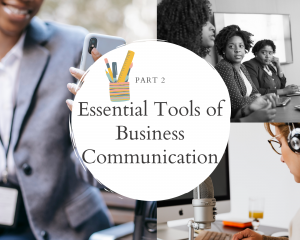2.0 Introduction to Part 2: Essential Tools of Business Communication
Linda Macdonald and Kayler Mutyabule

Part 2 Learning Objectives
By the end of Part 2, you should be able to
- Identify and apply Aristotle’s rhetorical elements of logos, ethos, and pathos,
- Develop skills in rhetorical listening,
- Identify and apply techniques of visual rhetoric,
- Apply the cognate strategies in oral and written communication,
- Identify reliable sources, and
- Use fact-checking strategies on online sources.
Part 2 addresses important techniques for creating effective business communication in written and oral business communication.
The first four chapters concern rhetoric. A quick search of the definition of “rhetoric” reveals very different uses of the word. The first definition in the Cambridge Dictionary is “speech or writing intended to be effective and influence people”. The University of Iowa defines rhetoric as “the study and art of writing and speaking well, being persuasive, and knowing how to compose successful writing and presentations.” But today, the word “rhetoric” has assumed negative connotations. The first definition of “rhetoric” provided by Dictionary.com is “(in writing or speech) the undue use of exaggeration or display; bombast”.
In “Rhetoric: Positive, negative, or both” (2013), Anne Curzan defines rhetoric as “the art of using language effectively in order to persuade others” (para. 3). Michigan Radio Newsroom’s three-minute interview with Curzan explains the shift in the connotations of the word over the last decades toward the dark side. Now, according to Curzan, “rhetoric” has negative as well as positive and neutral meanings.
In this textbook, “rhetoric” is defined positively as communication techniques artfully and logically selected to achieve a specific purpose and adapted to the needs of a particular audience, context, and channel.
In addition to rhetorical devices, Part 2 also addresses the essential skills of web literacy. Misinformation (inaccurate information) and disinformation (information intentionally false or misleading) are pervasive disruptors of society and of business. Learning how to choose reliable sources and how to verify information in social media posts can contribute to the success of your own personal brand as well as that of your employer.
References
Davis, A. (July 28, 2013). Rhetoric: Positive, negative, or both. Michigan Radio Newsroom. https://www.michiganradio.org/post/rhetoric-postive-negative-or-both

